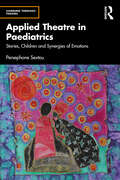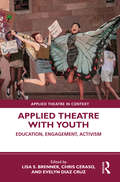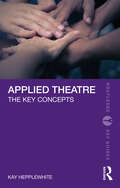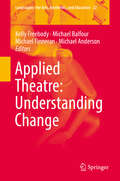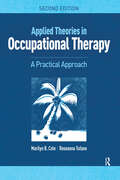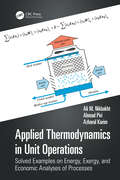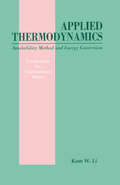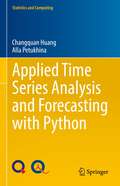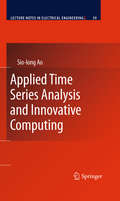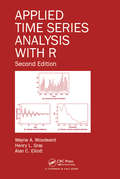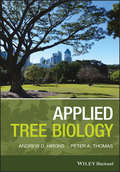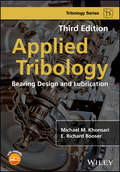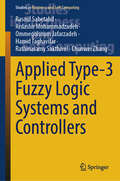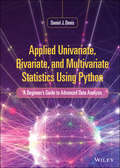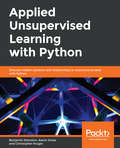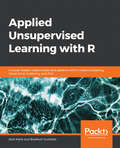- Table View
- List View
Applied Theatre in Paediatrics: Stories, Children and Synergies of Emotions (Learning Through Theatre)
by Persephone SextouThis book explores applied theatre practice for children in environments of illness and cure and how it can powerfully normalise children’s hospitalisation experience. It is an essential tool for making meaning of children’s illness, putting it into a fictional context and developing better control of their clinical experiences. It can be central to raising the standards of care and quality of life during illness. Taken from the author’s research and participatory bedside theatre practice in hospitals before, during and after the COVID-19 pandemic, this book demonstrates new learning about aesthetics, ethics, emotions, stories, puppetry, digital arts and research methodologies about children’s health and wellbeing. It provides a selection of ten unique stories told by children inspired by applied theatre practice in paediatrics, cardiac, oncology, neurosurgery, burns units and complex and intensive care wards. Stories aid in understanding the language of children’s pain for a better assessment and management of pain by healthcare professionals through the arts. It analyses synergistic theatre performance in 'stitched lands' between challenging realities and safe fictionalities. This book enables artists to develop new ways of thinking and contributes to further improvements in the provision of education and reflective learning in the field. It also addresses the emotional labour of the artist in healthcare and makes recommendations for balanced training to prevent emotional exhaustion. Designed for artists, healthcare professionals, therapists, play specialists and teachers who work with children in healthcare, this text aims to help many people find creative ways of making a positive difference in sick children’s lives. It is a book for those who love and care for children.
Applied Theatre with Youth: Education, Engagement, Activism (Applied Theatre in Context)
by Lisa S. Brenner, Chris Ceraso, and Evelyn Diaz CruzApplied Theatre with Youth is a collection of essays that highlight the value and efficacy of applied theatre with young people in a broad range of settings, addressing challenges and offering concrete solutions. This book tackles the vital issues of our time—including, among others, racism, climate crisis, gun violence, immigration, and gender—fostering dialogue, promoting education, and inciting social change. The book is divided into thematic sections, each opening with an essay addressing a range of questions about the benefits, challenges, and learning opportunities of a particular type of applied theatre. These are followed by response essays from theatre practitioners, discussing how their own approach aligns with and/or diverges from that of the initial essay. Each section then ends with a moderated roundtable discussion between the essays’ authors, further exploring the themes, issues, and ideas that they have introduced. With its accessible format and clear language, Applied Theatre with Youth is a valuable resource for theatre practitioners and the growing number of theatre companies with education and community engagement programs. Additionally, it provides essential reading for teachers and students in a myriad of fields: education, theatre, civic engagement, criminal justice, sociology, women and gender studies, environmental studies, disability studies, ethnicity and race studies.
Applied Theatre: The Key Concepts (Routledge Key Guides)
by Kay HepplewhiteThis accessible book outlines the key ideas that define the global phenomenon of applied theatre, not only its theoretical underpinning, its origins and practice, but also providing eight real-life examples drawn from a diversity of forms and settings.The clearly arranged topic sections entitled When, What, Who, Why and Where emphasise the responsive nature of applied theatre, its social context and the importance of a beneficial outcome for participants, which can connect fields as disparate as health, criminal justice, education and migration. Labels and terms are explained, along with applied theatre’s core values, motivations and objectives, allowing the reader to build a coherent understanding of its distinguishing features.Applied Theatre: The Key Concepts is aimed at students, academics, artists and practitioners of applied theatre as well as those with an interest in this vital blend of social and creative practice.
Applied Theatre: Understanding Change (Landscapes: the Arts, Aesthetics, and Education #22)
by Michael Anderson Kelly Freebody Michael Balfour Michael FinneranThis volume offers researchers and practitioners new perspectives on applied theatre work, exploring the relationship between applied theatre and its intent, success and value. Applied theatre is a well-established field focused on the social application of the arts in a range of contexts including schools, prisons, residential aged care and community settings. The increased uptake of applied theatre in these contexts requires increased analysis and understanding of indications of success and value. This volume provides critical commentary and questions regarding issues associated with developing, delivering and evaluating applied theatre programs. Part 1 of the volume presents a discussion of the ways the concept of change is presented to and by funding bodies, practitioners, participants, researchers and policy makers to discover and analyse the relationships between applied theatre practice, transformative intent, and evaluation. Part 2 of the volume offers perspectives from key authors in the field which extend and contextualize the discussion by examining key themes and practice-based examples.
Applied Theories in Occupational Therapy: A Practical Approach
by Marilyn B. Cole Roseanna TufanoApplied Theories in Occupational Therapy: A Practical Approach provides a comprehensive overview of theories and frames of reference in occupational therapy.
Applied Theories in Occupational Therapy: A Practical Approach
by Marilyn B. Cole Roseanna TufanoApplied Theories in Occupational Therapy: A Practical Approach, Second Edition provides a system-based, comprehensive overview of the theories, models, and frames of reference that influence occupational therapy around the world. Esteemed authors Marilyn B. Cole and Roseanna Tufano have updated their foundational text with an evidence-based focus derived from their experiences of more than 30 years teaching theoretical content to students. <P><P> Applied Theories in Occupational Therapy: A Practical Approach, Second Edition offers practical templates to help readers learn the key constructs of each theory and assimilate knowledge based on Mosey’s organizational structure. Each theory-based chapter is designed for ease in gathering content knowledge and comparing theories in a distinctive manner. The book includes: Summaries of the current trends found in practice, along with external influential models of health and wellness impacting populations of concern Exploration of some of the most common occupation-based models around the world. Each model’s holistic conceptual nature is described, including theoretical assumptions and practice guidelines for evaluation and intervention Reviews of common frames of reference found in evidence-based practice, which address the secondary and tertiary needs of common populations In this Edition, learning activities and case-based analyses strengthen the application of theory into current practice contexts. Practical guidelines assist the reader in formulating an evaluation process and determining the relevant intervention strategies that promote occupational participation, engagement, and functioning across the lifespan and the continuum of health. Instructors in educational settings can visit www.efacultylounge.com for additional education material to be used for teaching in the classroom.
Applied Theories in Occupational Therapy: A Practical Approach
by Marilyn B. Cole Roseanna TufanoApplied Theories in Occupational Therapy: A Practical Approach, Second Edition provides a system-based, comprehensive overview of the theories, models, and frames of reference that influence occupational therapy around the world. Esteemed authors Marilyn B. Cole and Roseanna Tufano have updated their foundational text with an evidence-based focus derived from their experiences of more than 30 years teaching theoretical content to students. Applied Theories in Occupational Therapy: A Practical Approach, Second Edition offers practical templates to help readers learn the key constructs of each theory and assimilate knowledge based on Mosey’s organizational structure. Each theory-based chapter is designed for ease in gathering content knowledge and comparing theories in a distinctive manner. The book includes: Summaries of the current trends found in practice, along with external influential models of health and wellness impacting populations of concern Exploration of some of the most common occupation-based models around the world. Each model’s holistic conceptual nature is described, including theoretical assumptions and practice guidelines for evaluation and intervention Reviews of common frames of reference found in evidence-based practice, which address the secondary and tertiary needs of common populations In this Edition, learning activities and case-based analyses strengthen the application of theory into current practice contexts. Practical guidelines assist the reader in formulating an evaluation process and determining the relevant intervention strategies that promote occupational participation, engagement, and functioning across the lifespan and the continuum of health.Included with the text are online supplemental materials for faculty use in the classroom.
Applied Therapeutics: The Clinical Use Of Drugs
by Caroline S. Zeind Michael G. CarvalhoContinually revised and updated for over 40 years, Applied Therapeutics: The Clinical Use of Drugsis the gold standard for patient-centered drug therapeutics.
Applied Thermodynamics for Meteorologists
by Miller SamThis textbook on atmospheric thermodynamics is for students of meteorology or atmospheric science. It also serves as a reference text for working professionals in meteorology and weather forecasting. It is unique because it provides complete, calculus-based derivations of basic physics from first principles, and connects mathematical relationships to real-world, practical weather forecasting applications. Worked examples and practice problems are included throughout.
Applied Thermodynamics in Unit Operations: Solved Examples on Energy, Exergy, and Economic Analyses of Processes
by Azharul Karim Ali M. Nikbakht Ahmad PiriThe growing demand of energy accounting in industries is the main challenge for academics and engineers working in chemical processing plants, food industries, and the energy sector. Applied Thermodynamics in Unit Operations addresses this demand and offers a clear contribution to the quantification of energy consumption in processes, while also solving the economic aspects of energy that are vital in real-life industrial contexts. Features• Combines the energy and exergy routines to analyze utilities and unit operations in a wide range of engineering scopes: nozzles, turbines, compressors, evaporators, HVAC, drying technology, steam handling, and power generation. • Offers a detailed procedure of finding economic wealth of energy in the operations. • Discusses basic concepts of thermal engineering and industrial operational insights through practiced examples, schematic illustrations, and software codes. • The only book to include practical problems of industrial operations solved in detail and complementary EES codes for the solutions. • Features examples selected from authors’ real-world experience in industrial projects. The book is a handy reference for researchers and practitioners in the areas of process, chemical, and mechanical engineering, undergraduate and postgraduate students in those disciplines, and engineers working in industry and production managers. Some examples are solved in EES to help the audience apply computer coding for thermal calculations.
Applied Thermodynamics: Availability Method And Energy Conversion (Combustion: An International Series #5)
by KamW. LiDeals with the availability method and its application to power plant system design and energy conversion. The first part of the book describes the development and the formulation of the availability method. The second part presents its applications to energy conversion processes. Examples for each energy conversion system are introduced and there are practice problems throughout the text.
Applied Time Series Analysis and Forecasting with Python (Statistics and Computing)
by Changquan Huang Alla PetukhinaThis textbook presents methods and techniques for time series analysis and forecasting and shows how to use Python to implement them and solve data science problems. It covers not only common statistical approaches and time series models, including ARMA, SARIMA, VAR, GARCH and state space and Markov switching models for (non)stationary, multivariate and financial time series, but also modern machine learning procedures and challenges for time series forecasting. Providing an organic combination of the principles of time series analysis and Python programming, it enables the reader to study methods and techniques and practice writing and running Python code at the same time. Its data-driven approach to analyzing and modeling time series data helps new learners to visualize and interpret both the raw data and its computed results. Primarily intended for students of statistics, economics and data science with an undergraduate knowledge of probability and statistics, the book will equally appeal to industry professionals in the fields of artificial intelligence and data science, and anyone interested in using Python to solve time series problems.
Applied Time Series Analysis and Innovative Computing (Lecture Notes In Electrical Engineering #59)
by Sio-Iong AoApplied Time Series Analysis and Innovative Computing contains the applied time series analysis and innovative computing paradigms, with frontier application studies for the time series problems based on the recent works at the Oxford University Computing Laboratory, University of Oxford, the University of Hong Kong, and the Chinese University of Hong Kong. The monograph was drafted when the author was a post-doctoral fellow in Harvard School of Engineering and Applied Sciences, Harvard University. It provides a systematic introduction to the use of innovative computing paradigms as an investigative tool for applications in time series analysis. Applied Time Series Analysis and Innovative Computing offers the state of art of tremendous advances in applied time series analysis and innovative computing paradigms and also serves as an excellent reference work for researchers and graduate students working on applied time series analysis and innovative computing paradigms.
Applied Time Series Analysis with R
by Alan C. Elliott Wayne A. Woodward Henry L. GrayVirtually any random process developing chronologically can be viewed as a time series. In economics closing prices of stocks, the cost of money, the jobless rate, and retail sales are just a few examples of many. Developed from course notes and extensively classroom-tested, Applied Time Series Analysis with R, Second Edition includes examples across a variety of fields, develops theory, and provides an R-based software package to aid in addressing time series problems in a broad spectrum of fields. The material is organized in an optimal format for graduate students in statistics as well as in the natural and social sciences to learn to use and understand the tools of applied time series analysis. Features Gives readers the ability to actually solve significant real-world problems Addresses many types of nonstationary time series and cutting-edge methodologies Promotes understanding of the data and associated models rather than viewing it as the output of a "black box" Provides the R package tswge available on CRAN which contains functions and over 100 real and simulated data sets to accompany the book. Extensive help regarding the use of tswge functions is provided in appendices and on an associated website. Over 150 exercises and extensive support for instructors The second edition includes additional real-data examples, uses R-based code that helps students easily analyze data, generate realizations from models, and explore the associated characteristics. It also adds discussion of new advances in the analysis of long memory data and data with time-varying frequencies (TVF).
Applied Topics in Health Psychology
by Lina Ricciardelli Marie Louise CaltabianoThis selection of in-depth, critical and comprehensive chapters on topical issues in applied health psychology features the work of key researchers and practitioners in the Australasian health system and deals with both theoretical and methodological aspects of the subject.The first health psychology text aimed specifically at regional postgraduate traineesCovers an array of topics and issues and focuses on applied aspects of clinical health and health promotionIncludes both specialized topics and new frontiers of researchContextualizes health psychology teaching and learning for Australasian students
Applied Tree Biology
by Peter A. Thomas Andrew HironsMany arborists learn tree work practices without fully understanding the biological and physiological principles behind them. However, outcomes for the health and longevity of trees are greatly improved when an arborist understands the science behind the care of tree root systems and crowns. In Applied Tree Biology, Drs. Hirons and Thomas draw upon their decades of experience in the laboratory, classroom, and the field – as well as the expertise of distinguished contributors to this volume – to provide those responsible for tree care with the scientific information that informs best practices for planting, pruning, soil decompaction, irrigation, and much more. Takes a multidisciplinary approach, integrating knowledge from plant biology, physiology, arboriculture, ecology, and more Provides a systematic presentation of fundamental tree biology and the scientific principles informing high quality tree care Presents accessible scientific information and best practices that help promote the health and longevity of trees Reflects the authors’ decades of experience as tree biology researchers and educators, as well as their years of professional experience across the globe Applied Tree Biology is an indispensable source of practical, succinct information on tree biology, physiology, and ecology for professionals and interested amateurs involved with the care of trees. Arborists, foresters, and horticulturists at all stages of their careers will find this text particularly useful.
Applied Tribology: Bearing Design and Lubrication
by E. Richard Booser Michael M. KhonsariApplications of tribological technology in bearings are wide and varied in industries ranging from aerospace, marine and automotive to power, process, petrochemical and construction. Applied Tribology, 2nd edition not only covers tribology in bearings but demonstrates the same principles for other machine components, such as piston pins, piston rings and hydrostatic lifts, as well as in more recent technologies such as gas bearings in high-speed machines and computer read-write devices. Maintaining a balance between theoretical analysis and practical experience with co-authors from academia and industry, this new edition is significantly revised and expanded with new material. Features include; - Two brand new chapters on seals and bearing failure modes and bearing health monitoring techniques- Coverage of new developments in full-film, dry, and partial lubrication; gas bearings; and ball and roller bearings- Design guides based on full Reynolds equation that enable accurate prediction of load capacity, power loss, temperature rise- Comprehensive presentation of important design factors involving material and lubricants. - State-of-the-art presentation and up-to-date references of pertinent scientific and applied topics in tribology- Numerous examples that reinforce the understanding of concepts and provide procedures for the design and performance analysis of components Applied Tribology, 2nd edition provides a valuable and authoritative resource for mechanical engineering professionals working in a wide range of industries with machinery including turbines, compressors, motors, electrical appliances & electronic components. Senior and graduate students in mechanical engineering will also find it a useful text and reference.
Applied Type-3 Fuzzy Logic Systems and Controllers (Studies in Fuzziness and Soft Computing #417)
by Hamid Taghavifar Chunwei Zhang Rathinasamy Sakthivel Ardashir Mohammadzadeh Rasoul Sabetahd Ommegolsoum JafarzadehThis book provides the fundamental approaches to designing and using type-3 fuzzy systems in real-world applications. Basic Matlab codes are provided to use type-3 fuzzy systems in a straightforward scheme. The main differences between type-3 fuzzy systems and other types are analyzed and compared. The effectiveness of type-3 fuzzy systems is analyzed and studied in various applications, such as robotics, intelligent control systems, and data science.
Applied Univariate, Bivariate and Multivariate Statistics
by Daniel J. DenisA clear and efficient balance between theory and application of statistical modeling techniques in the social and behavioral sciences Written as a general and accessible introduction, Applied Univariate, Bivariate, and Multivariate Statistics provides an overview of statistical modeling techniques used in fields in the social and behavioral sciences. Blending statistical theory and methodology, the book surveys both the technical and theoretical aspects of good data analysis. Featuring applied resources at various levels, the book includes statistical techniques such as t-tests and correlation as well as more advanced procedures such as MANOVA, factor analysis, and structural equation modeling. To promote a more in-depth interpretation of statistical techniques across the sciences, the book surveys some of the technical arguments underlying formulas and equations. Applied Univariate, Bivariate, and Multivariate Statistics also features Demonstrations of statistical techniques using software packages such as R and SPSS® Examples of hypothetical and real data with subsequent statistical analyses Historical and philosophical insights into many of the techniques used in modern social science A companion website that includes further instructional details, additional data sets, solutions to selected exercises, and multiple programming options An ideal textbook for courses in statistics and methodology at the upper-undergraduate and graduate-levels in psychology, political science, biology, sociology, education, economics, communications, law, and survey research, Applied Univariate, Bivariate, and Multivariate Statistics is also a useful reference for practitioners and researchers in their field of application.
Applied Univariate, Bivariate, and Multivariate Statistics Using Python: A Beginner's Guide to Advanced Data Analysis
by Daniel J. DenisApplied Univariate, Bivariate, and Multivariate Statistics Using Python A practical, “how-to” reference for anyone performing essential statistical analyses and data management tasks in PythonApplied Univariate, Bivariate, and Multivariate Statistics Using Python delivers a comprehensive introduction to a wide range of statistical methods performed using Python in a single, one-stop reference. The book contains user-friendly guidance and instructions on using Python to run a variety of statistical procedures without getting bogged down in unnecessary theory. Throughout, the author emphasizes a set of computational tools used in the discovery of empirical patterns, as well as several popular statistical analyses and data management tasks that can be immediately applied.Most of the datasets used in the book are small enough to be easily entered into Python manually, though they can also be downloaded for free from www.datapsyc.com. Only minimal knowledge of statistics is assumed, making the book perfect for those seeking an easily accessible toolkit for statistical analysis with Python. Applied Univariate, Bivariate, and Multivariate Statistics Using Python represents the fastest way to learn how to analyze data with Python.Readers will also benefit from the inclusion of:A review of essential statistical principles, including types of data, measurement, significance tests, significance levels, and type I and type II errorsAn introduction to Python, exploring how to communicate with PythonA treatment of exploratory data analysis, basic statistics and visual displays, including frequencies and descriptives, q-q plots, box-and-whisker plots, and data managementAn introduction to topics such as ANOVA, MANOVA and discriminant analysis, regression, principal components analysis, factor analysis, cluster analysis, among others, exploring the nature of what these techniques can vs. cannot do on a methodological levelPerfect for undergraduate and graduate students in the social, behavioral, and natural sciences, Applied Univariate, Bivariate, and Multivariate Statistics Using Python will also earn a place in the libraries of researchers and data analysts seeking a quick go-to resource for univariate, bivariate, and multivariate analysis in Python.
Applied Univariate, Bivariate, and Multivariate Statistics: Understanding Statistics for Social and Natural Scientists, With Applications in SPSS and R
by Daniel J. DenisAN UPDATED GUIDE TO STATISTICAL MODELING TECHNIQUES USED IN THE SOCIAL AND BEHAVIORAL SCIENCES The revised and updated second edition of Applied Univariate, Bivariate, and Multivariate Statistics: Understanding Statistics for Social and Natural Scientists, with Applications in SPSS and R contains an accessible introduction to statistical modeling techniques commonly used in the social and behavioral sciences. The text offers a blend of statistical theory and methodology and reviews both the technical and theoretical aspects of good data analysis. Featuring applied resources at various levels, the book includes statistical techniques using software packages such as R and SPSS®. To promote a more in-depth interpretation of statistical techniques across the sciences, the book surveys some of the technical arguments underlying formulas and equations. The thoroughly updated edition includes new chapters on nonparametric statistics and multidimensional scaling, and expanded coverage of time series models. The second edition has been designed to be more approachable by minimizing theoretical or technical jargon and maximizing conceptual understanding with easy-to-apply software examples. This important text: Offers demonstrations of statistical techniques using software packages such as R and SPSS® Contains examples of hypothetical and real data with statistical analyses Provides historical and philosophical insights into many of the techniques used in modern social science Includes a companion website that includes further instructional details, additional data sets, solutions to selected exercises, and multiple programming options Written for students of social and applied sciences, Applied Univariate, Bivariate, and Multivariate Statistics, Second Edition offers a text to statistical modeling techniques used in social and behavioral sciences.
Applied Unsupervised Learning with Python: Discover hidden patterns and relationships in unstructured data with Python
by Benjamin Johnston Aaron Jones Christopher KrugerDesign clever algorithms that can uncover interesting structures and hidden relationships in unstructured, unlabeled dataKey FeaturesLearn how to select the most suitable Python library to solve your problemCompare k-Nearest Neighbor (k-NN) and non-parametric methods and decide when to use themDelve into the applications of neural networks using real-world datasetsBook DescriptionUnsupervised learning is a useful and practical solution in situations where labeled data is not available. Applied Unsupervised Learning with Python guides you on the best practices for using unsupervised learning techniques in tandem with Python libraries and extracting meaningful information from unstructured data. The course begins by explaining how basic clustering works to find similar data points in a set. Once you are well versed with the k-means algorithm and how it operates, you’ll learn what dimensionality reduction is and where to apply it. As you progress, you’ll learn various neural network techniques and how they can improve your model. While studying the applications of unsupervised learning, you will also understand how to mine topics that are trending on Twitter and Facebook and build a news recommendation engine for users. You will complete the course by challenging yourself through various interesting activities such as performing a Market Basket Analysis and identifying relationships between different merchandises. By the end of this course, you will have the skills you need to confidently build your own models using Python.What you will learnUnderstand the basics and importance of clusteringBuild k-means, hierarchical, and DBSCAN clustering algorithms from scratch with built-in packagesExplore dimensionality reduction and its applicationsUse scikit-learn (sklearn) to implement and analyse principal component analysis (PCA)on the Iris datasetEmploy Keras to build autoencoder models for the CIFAR-10 datasetApply the Apriori algorithm with machine learning extensions (Mlxtend) to study transaction dataWho this book is forThis course is designed for developers, data scientists, and machine learning enthusiasts who are interested in unsupervised learning. Some familiarity with Python programming along with basic knowledge of mathematical concepts including exponents, square roots, means, and medians will be beneficial.
Applied Unsupervised Learning with R
by Bradford TuckfieldApplied Unsupervised Learning with R is designed for business professionals, who want to learn about methods to understand their data better, and developers, who have an interest in unsupervised learning. It'll help you to have basic, beginner-level familiarity with R, including how to open the R console, how to read data, and how to create a loop. To easily understand the concepts of this book, you should know basic mathematical concepts, such as exponents, square roots, means, and medians.
Applied Urban Analysis: A critique and synthesis
by Ian CullenMuch of the theoretical literature in planning and human geography at present is materialist in perspective. This offers a powerful critique but locates the dynamics of urban systems too specifically in just one basic social relationship. It fails to provide an intellectual base broad enough for constructive, detailed urban analysis, partly because it fails to do justice to the reflective awareness of the individual. The alternative humanist position redresses the balance in favour of the individual but again cannot serve the practical requirements of urban analysis since it so often ignores social or contextual analysis. Ian Cullen synthesizes these tow apparently inconsistent theoretical positions and to render the increasingly obscure debate between them accessible. This book was first published in 1984.
Applied Urban Design: A Contextually Responsive Approach
by Michael Martin Robert Phillips Philip Black Taki SonbliApplied Urban Design combines 'why' we design and 'who' we design for, with 'how' we design, by providing the reader with a comprehensive and accessible bespoke framework for both understanding and practicing urban design in a contextually responsive manner from appraisal to design delivery. The framework is presented across four distinct steps, covering analysis at strategic and local scales; the urban design program; design development; and technical design. The authors unpack the functional blueprints, liveable qualities, contextual dynamics, and technical components of quality urban design, identifying the role of urban designers in shaping spaces and places across differing local contexts through a responsive and multiscalar approach. International best practice examples and two original ‘live’ case studies in Aalborg, Denmark and Manchester, UK demonstrate the application of the framework across differing scales and contexts – each supported by authors own images and graphics that illustrate the broad range of urban design visualisation techniques and methods.Visually compelling and insightful, Applied Urban Design is for all who seek to understand, demand, and create people-centred, high-quality, contextually responsive places and spaces.
